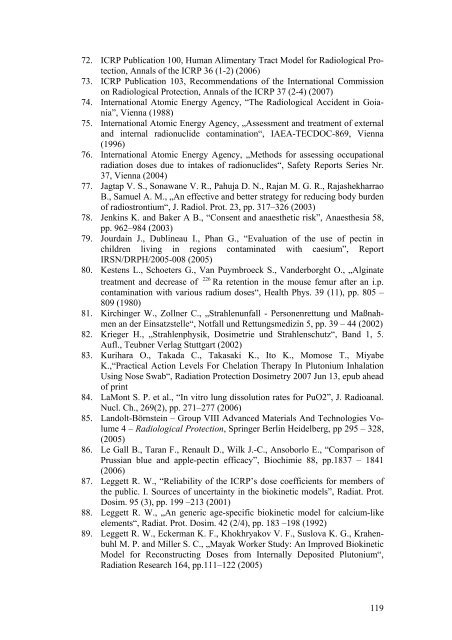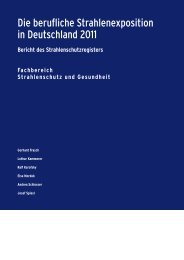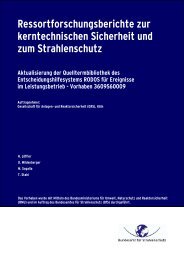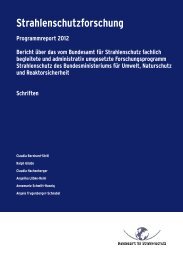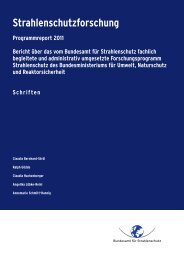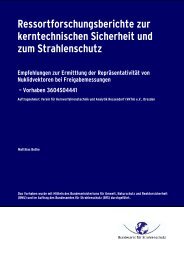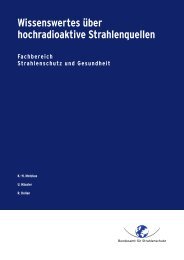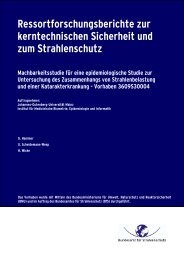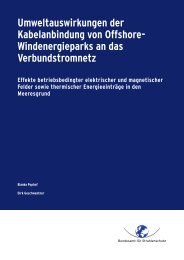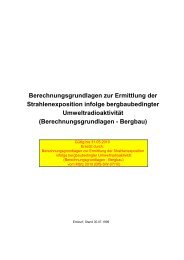Materialsammlung zur internen Radiodekontamination von Personen
Materialsammlung zur internen Radiodekontamination von Personen
Materialsammlung zur internen Radiodekontamination von Personen
Sie wollen auch ein ePaper? Erhöhen Sie die Reichweite Ihrer Titel.
YUMPU macht aus Druck-PDFs automatisch weboptimierte ePaper, die Google liebt.
72. ICRP Publication 100, Human Alimentary Tract Model for Radiological Protection,<br />
Annals of the ICRP 36 (1-2) (2006)<br />
73. ICRP Publication 103, Recommendations of the International Commission<br />
on Radiological Protection, Annals of the ICRP 37 (2-4) (2007)<br />
74. International Atomic Energy Agency, “The Radiological Accident in Goiania”,<br />
Vienna (1988)<br />
75. International Atomic Energy Agency, „Assessment and treatment of external<br />
and internal radionuclide contamination“, IAEA-TECDOC-869, Vienna<br />
(1996)<br />
76. International Atomic Energy Agency, „Methods for assessing occupational<br />
radiation doses due to intakes of radionuclides“, Safety Reports Series Nr.<br />
37, Vienna (2004)<br />
77. Jagtap V. S., Sonawane V. R., Pahuja D. N., Rajan M. G. R., Rajashekharrao<br />
B., Samuel A. M., „An effective and better strategy for reducing body burden<br />
of radiostrontium“, J. Radiol. Prot. 23, pp. 317–326 (2003)<br />
78. Jenkins K. and Baker A B., “Consent and anaesthetic risk”, Anaesthesia 58,<br />
pp. 962–984 (2003)<br />
79. Jourdain J., Dublineau I., Phan G., “Evaluation of the use of pectin in<br />
children living in regions contaminated with caesium”, Report<br />
IRSN/DRPH/2005-008 (2005)<br />
80. Kestens L., Schoeters G., Van Puymbroeck S., Vanderborght O., „Alginate<br />
treatment and decrease of 226 Ra retention in the mouse femur after an i.p.<br />
contamination with various radium doses“, Health Phys. 39 (11), pp. 805 –<br />
809 (1980)<br />
81. Kirchinger W., Zollner C., „Strahlenunfall - <strong>Personen</strong>rettung und Maßnahmen<br />
an der Einsatzstelle“, Notfall und Rettungsmedizin 5, pp. 39 – 44 (2002)<br />
82. Krieger H., „Strahlenphysik, Dosimetrie und Strahlenschutz“, Band 1, 5.<br />
Aufl., Teubner Verlag Stuttgart (2002)<br />
83. Kurihara O., Takada C., Takasaki K., Ito K., Momose T., Miyabe<br />
K.,“Practical Action Levels For Chelation Therapy In Plutonium Inhalation<br />
Using Nose Swab“, Radiation Protection Dosimetry 2007 Jun 13, epub ahead<br />
of print<br />
84. LaMont S. P. et al., “In vitro lung dissolution rates for PuO2”, J. Radioanal.<br />
Nucl. Ch., 269(2), pp. 271–277 (2006)<br />
85. Landolt-Börnstein – Group VIII Advanced Materials And Technologies Volume<br />
4 – Radiological Protection, Springer Berlin Heidelberg, pp 295 – 328,<br />
(2005)<br />
86. Le Gall B., Taran F., Renault D., Wilk J.-C., Ansoborlo E., “Comparison of<br />
Prussian blue and apple-pectin efficacy”, Biochimie 88, pp.1837 – 1841<br />
(2006)<br />
87. Leggett R. W., “Reliability of the ICRP’s dose coefficients for members of<br />
the public. I. Sources of uncertainty in the biokinetic models”, Radiat. Prot.<br />
Dosim. 95 (3), pp. 199 –213 (2001)<br />
88. Leggett R. W., „An generic age-specific biokinetic model for calcium-like<br />
elements“, Radiat. Prot. Dosim. 42 (2/4), pp. 183 –198 (1992)<br />
89. Leggett R. W., Eckerman K. F., Khokhryakov V. F., Suslova K. G., Krahenbuhl<br />
M. P. and Miller S. C., „Mayak Worker Study: An Improved Biokinetic<br />
Model for Reconstructing Doses from Internally Deposited Plutonium“,<br />
Radiation Research 164, pp.111–122 (2005)<br />
119


